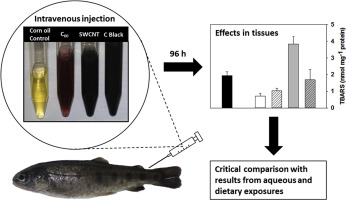Environmental Pollution ( IF 8.9 ) Pub Date : 2017-09-20 , DOI: 10.1016/j.envpol.2017.09.033 David Boyle , Paul A. Sutton , Richard D. Handy , Theodore B. Henry

|
Numerous ecotoxicology studies of carbon-based nanomaterials (CNMs) have been conducted in fishes; however, different approaches have been used to make CNM dispersions and dose tanks for aqueous exposures, and to prepare food containing CNMs for dietary studies. This diversity of experimental methods has led to conflicting results and difficulties in comparing studies. The objective of the present study was to evaluate intravenous injection of unfunctionalized CNMs in rainbow trout (Oncorhynchus mykiss), as a means of delivering a known internal dose, on tissue biochemistry and histopathological lesions; then, subsequently, to compare the results with our previous work on aqueous and dietary exposures of rainbow trout to CNMs. Rainbow trout were injected in the caudal vein with corn oil dispersions of 200 μg (approximately 1 μg g−1) of either the fullerene C60, single-walled carbon nanotubes (SWCNTs), or amorphous carbon black. After 96 h, injected fish were euthanized and tissue samples collected for biochemistry and histology. Histological examination of the kidney of fish injected intravenously indicated the presence of black material consistent with the injected carbon treatments. However, there were no additional lesions associated with CNM exposure compared to controls. There were also no significant changes in haematology, or ionoregulatory disturbance in blood plasma among the intravenously injected fish. Significant elevation in lipid peroxidation (thiobarbituric acid reactive substances TBARS) was detected only in kidney and spleen of fish injected with SWCNTs, but not the other carbon treatments. The elevated TBARS following injection contrasted with CNMs delivered via aqueous or dietary routes in our previous studies, suggesting that the latter exposure routes may not lead to absorption and toxicity in the internal tissues. Comparison of the effects of injected CNMs with aqueous and dietary CNMs exposures indicates that these materials are of minimal environmentally-relevant toxicity in rainbow trout.
中文翻译:

静脉内注射未官能化的碳基纳米材料证实了在幼虹鳟(Oncorhynchus mykiss)的水和饮食暴露中观察到的最低毒性
在鱼类中进行了许多碳基纳米材料(CNMs)的生态毒理学研究。但是,已经采用了不同的方法来制造CNM分散液和剂量罐以进行水暴露,并准备用于饮食研究的含有CNM的食物。实验方法的多样性导致了相互矛盾的结果和比较研究的困难。本研究的目的是评估虹鳟鱼(Oncorhynchus mykiss)中未功能化CNM的静脉注射),作为传递已知内部剂量的方法,用于组织生物化学和组织病理学病变;然后,将其与我们先前关于虹鳟在CNM上的水和饮食暴露的研究结果进行比较。虹鳟鱼在尾静脉中注入200μg富勒烯C 60的玉米油分散液(约1μgg -1),单壁碳纳米管(SWCNT)或非晶碳黑。96小时后,对注入的鱼实施安乐死,并收集组织样本进行生物化学和组织学检查。静脉注射鱼的肾脏的组织学检查表明存在黑色物质,与注射的碳处理一致。但是,与对照组相比,没有其他与CNM暴露相关的病变。静脉注射鱼的血液学或血浆离子调节紊乱也无明显变化。仅在注射SWCNTs的鱼类的肾脏和脾脏中检测到脂质过氧化(硫代巴比妥酸反应性物质TBARS)显着升高,而其他碳处理则未检测到。在我们先前的研究中,注射后升高的TBARS与通过水或饮食途径递送的CNM形成对照,这表明后者的暴露途径可能不会导致内部组织的吸收和毒性。将注射的CNM与水和饮食中的CNM暴露的效果进行比较,结果表明,这些材料在虹鳟鱼中的环境毒性最小。



























 京公网安备 11010802027423号
京公网安备 11010802027423号